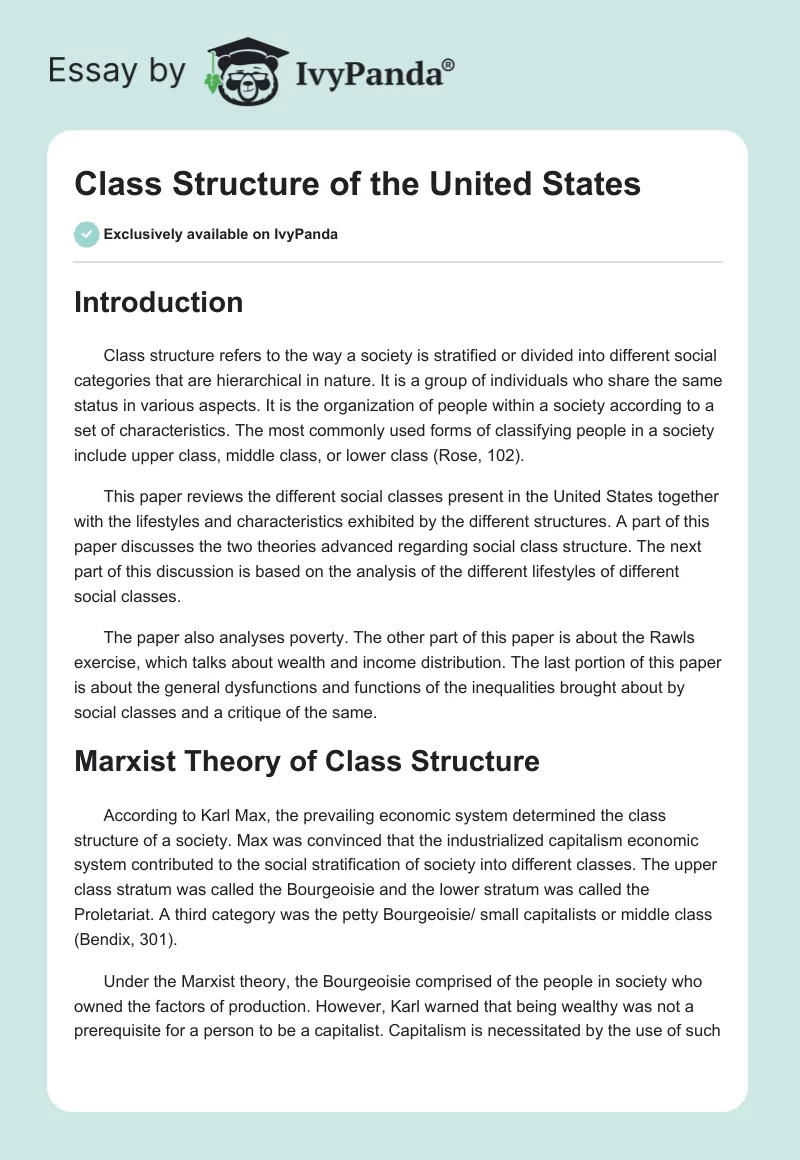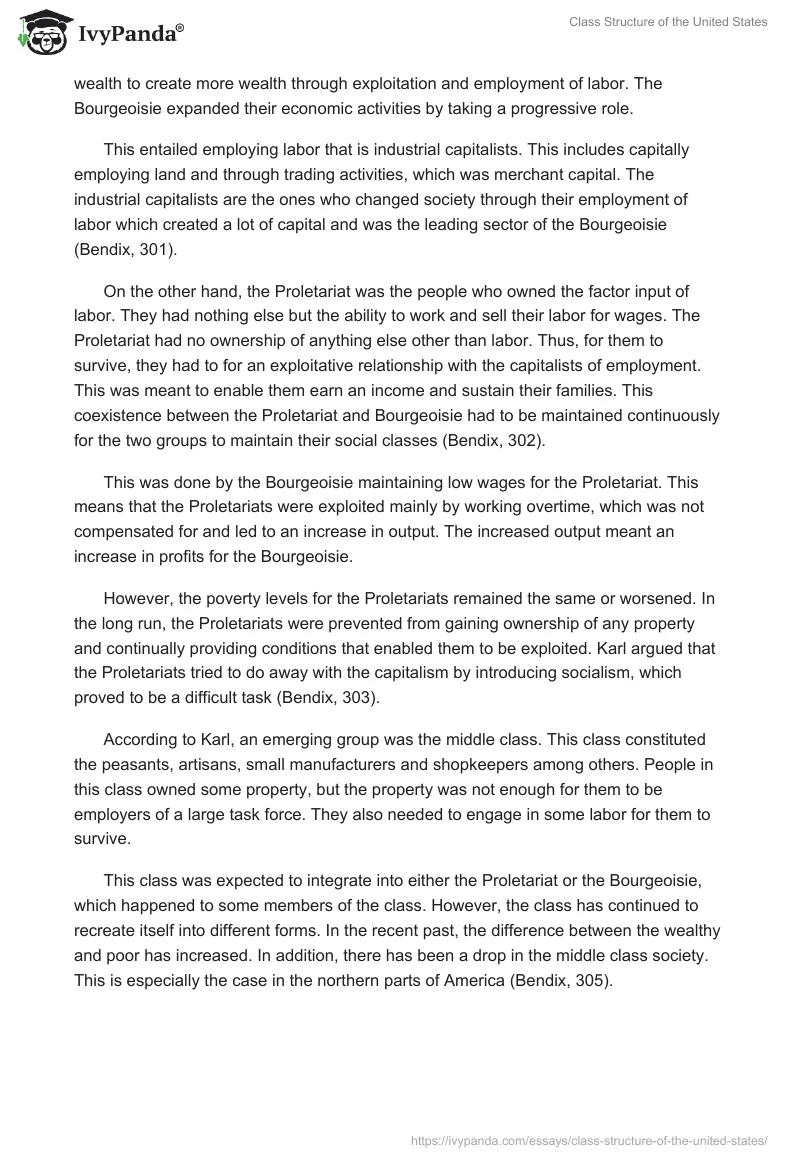Introduction
Class structure refers to the way a society is stratified or divided into different social categories that are hierarchical in nature. It is a group of individuals who share the same status in various aspects. It is the organization of people within a society according to a set of characteristics. The most commonly used forms of classifying people in a society include upper class, middle class, or lower class (Rose, 102).
This paper reviews the different social classes present in the United States together with the lifestyles and characteristics exhibited by the different structures. A part of this paper discusses the two theories advanced regarding social class structure. The next part of this discussion is based on the analysis of the different lifestyles of different social classes.
The paper also analyses poverty. The other part of this paper is about the Rawls exercise, which talks about wealth and income distribution. The last portion of this paper is about the general dysfunctions and functions of the inequalities brought about by social classes and a critique of the same.
Marxist Theory of Class Structure
According to Karl Max, the prevailing economic system determined the class structure of a society. Max was convinced that the industrialized capitalism economic system contributed to the social stratification of society into different classes. The upper class stratum was called the Bourgeoisie and the lower stratum was called the Proletariat. A third category was the petty Bourgeoisie/ small capitalists or middle class (Bendix, 301).
Under the Marxist theory, the Bourgeoisie comprised of the people in society who owned the factors of production. However, Karl warned that being wealthy was not a prerequisite for a person to be a capitalist. Capitalism is necessitated by the use of such wealth to create more wealth through exploitation and employment of labor. The Bourgeoisie expanded their economic activities by taking a progressive role.
This entailed employing labor that is industrial capitalists. This includes capitally employing land and through trading activities, which was merchant capital. The industrial capitalists are the ones who changed society through their employment of labor which created a lot of capital and was the leading sector of the Bourgeoisie (Bendix, 301).
On the other hand, the Proletariat was the people who owned the factor input of labor. They had nothing else but the ability to work and sell their labor for wages. The Proletariat had no ownership of anything else other than labor. Thus, for them to survive, they had to for an exploitative relationship with the capitalists of employment. This was meant to enable them earn an income and sustain their families. This coexistence between the Proletariat and Bourgeoisie had to be maintained continuously for the two groups to maintain their social classes (Bendix, 302).
This was done by the Bourgeoisie maintaining low wages for the Proletariat. This means that the Proletariats were exploited mainly by working overtime, which was not compensated for and led to an increase in output. The increased output meant an increase in profits for the Bourgeoisie.
However, the poverty levels for the Proletariats remained the same or worsened. In the long run, the Proletariats were prevented from gaining ownership of any property and continually providing conditions that enabled them to be exploited. Karl argued that the Proletariats tried to do away with the capitalism by introducing socialism, which proved to be a difficult task (Bendix, 303).
According to Karl, an emerging group was the middle class. This class constituted the peasants, artisans, small manufacturers and shopkeepers among others. People in this class owned some property, but the property was not enough for them to be employers of a large task force. They also needed to engage in some labor for them to survive.
This class was expected to integrate into either the Proletariat or the Bourgeoisie, which happened to some members of the class. However, the class has continued to recreate itself into different forms. In the recent past, the difference between the wealthy and poor has increased. In addition, there has been a drop in the middle class society. This is especially the case in the northern parts of America (Bendix, 305).
The Weberian Theory of Class Structure
Weber referred to the class as a group of individuals who had a casual common component in terms of economic interests in the ownership of commodities and opportunities to generate income. This was represented under the conditions of the labor market. Weber saw divisions in class as the main source of conflict in society. However, he noted that class is only a component of social structure with social status being another.
Weber argued that social stratification was dependent on more than just capital ownership. In this case, there existed aristocrats who had no economic wealth but yielded a lot of political power. He indicated instances where the Jews lacked power and reputation despite their enormous wealth (Giddens and Griffiths, 83).
According to Weber, there are three factors that are the pillars of his theory. These are class, status and power. Weber defined class as the economic position of a person. Nonetheless, he noted that this was not the determining factor of stratification because there are managers who control entire corporations without owning them.
Status is the popularity, prestige and honor that a person has in society. Weber noted that political power was not a result of capital ownership solely, but a person’s status also contributed to it. For instance, poets and saints can have a lot of influence in a society without having a lot of economic wealth. On the other hand, power refers to the capacity to forge a way forward in spite of hindrances. According to Weber, these were the determinants of social stratification (Giddens and Griffiths, 85).
Social and Economic Lifestyles among Different Social Classes
Different social classes possess different lifestyles. The lifestyle led by the rich and affluent is far different from that of either the middle class or the poor in society. This is depicted by various aspects of lifestyle including education, food, clothing, entertainment, societal positions and possessions (Rose, 142). A review of texts by William Domhoff and Barbara Ehrenreich shall further illustrate these differences in lifestyles.
William writes about the Bohemian Grove, which is an assembly of the most elite people in America annually. It consists of former presidents, famous television stars, well known bankers, and artists among other equally affluent members of the American society.
They have been meeting for over a hundred years for two weeks to indulge with each other and share ideas or just talk about the global happenings (Domhoff, 3). The Bohemians are the ruling social class in America. They make up about 1% of the total population but own between 25 and 30 percent of private wealth in America.
They also own between 60 and 70 percent of corporate wealth that is held privately and receive between 20 and 30 percent of the annual income. They are the same people who are in the federal government and are directors of the largest corporations in America. William also noted that these elitists see each other as equals to the extent of even ensuring intermarriage between themselves so as to maintain the status within their families. There are also clubs and even retreats like the Bohemian, which are exclusively for the elite and lead to a greater cohesion within this class of people (Domhoff, 97).
Barbara writes about her experience in trying to live the lifestyle of an ordinary member of the working class community. She finds that the jobs available for that class of people include delivery clerk jobs, hotel front desk clerk jobs, waitressing, telemarketing and housekeeping among others (Ehrenreich, 1).
All of these jobs pay between six and eight dollars an hour. This means that one can only afford to live in a house within the range of 500 to 600 dollars a month (The New York Times Company, para 2; Ehrenreich, 2). Such houses are not the best; for example, Barbara got a job as a waiter after initially being called in for housekeeping lives in a house where she pays a 500 dollar monthly rent while earning 2.43 dollars an hour plus tips (The New York Times Company, para 9).
Causes of Inequality and Functions of Poverty
The inequality in income and social class within America has been attributed to gender inequality or the inequality between blacks and whites. However, both of these have been on a decline and the latter stagnated. The general causes of inequality can be said to be race, gender, expertise, experience, inheritance and productivity. The actual causes include the disparities in the race and gender, education, technology, incentives and taxation (Rose, 187).
Poverty plays a crucial role in that it maintains the status of the middle and lower class in society. There is the dependence of the other classes on the upper class in society due to poverty levels. Poverty can be curbed, and the inequalities that are present today may be reduced (Rose, 191).
Rawls Exercise on Distribution of Wealth and Income
According to Rawl, legislation should be established to make the lowest economic and social status permitted to be higher than any status permitted by any other system of inequalities. This implies a feasible and the economic and social status that will be enjoyed by all under a system of policy and law that enacted economic and social equality.
Recommendation
The first area of interest is for America to eliminate the lower class so that there is an upper and middle class only. This means that the levels of poverty should be addressed. Secondly, the gap between the two classes needs to be reduced. This is meant to bring equality, and the country’s wealth is not left in the hands of a few elite people. This means that policies of wealth and income distribution must be enacted and implemented. That would be a healthy level of equality to maintain in any society.
Conclusion
Based on the study, it can be noted that social stratification is a long way from being over. Thus, society will always find a way of grouping itself based on the common characteristics or similarities that a group of people has. While social classes may not be a bad concept, there is the need to maintain them in a healthy manner that is suitable for everyone regardless of the class to which they belong.
Works Cited
Bendix, Reinhard. Karl Marx’ Theory of Social Classes. Berkeley: The Institute, 1954. Print.
Domhoff, William, G. The Bohemian Grove and Other Retreats: A Study in Ruling Class Cohesiveness. New York: Harper Colophon Books, 1975. Print.
Ehrenreich, Barbara. Nickel and Dimed On (Not) Getting By in America. New York: Henry Holt and Company, 2010. Print.
Giddens, Anthony, and Simon Griffiths. Sociology. Cambridge, UK [u.a.: Polity Press, 2006. Print.
Rose, Stephen J. Social Stratification in the United States: The American Profile Poster. New York: New Press, 2007. Print.
The New York Times Company. “CHAPTER ONE: Nickel and Dimed On (Not) Getting By in America By BARBARA EHRENREICH: Serving in Florida”. The New York Times. 2000. Web. https://archive.nytimes.com/www.nytimes.com/books/first/e/ehrenreich-01nickel.html


